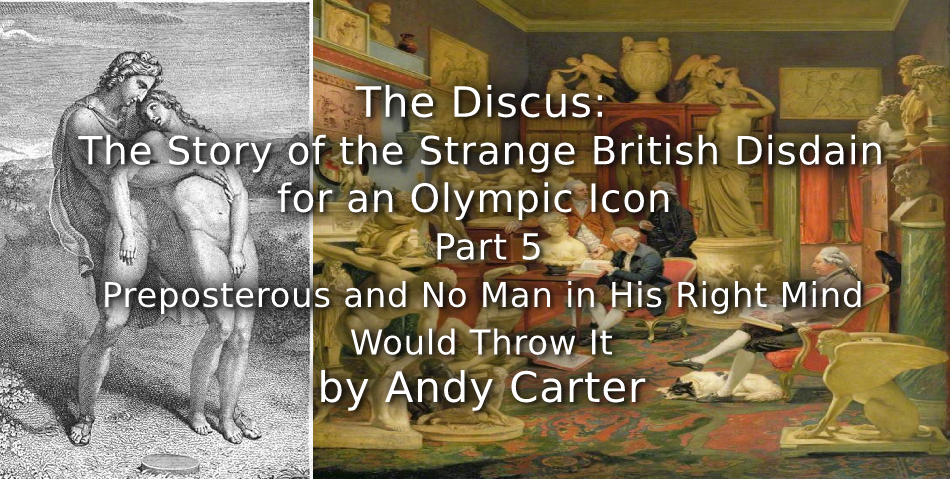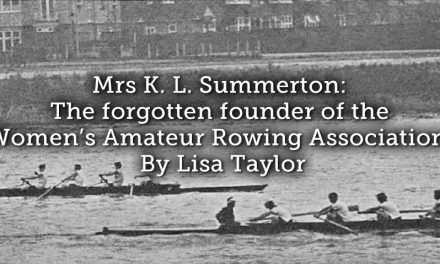To read Part 1: Classical Origins – Click HERE
Part 2: Early British Interest (and Disinterest!) in the Discus – Click HERE
Part 3: Greek Revival and British Academic Objections – Click HERE
Part 4: Part 4 ~ Norman Gardiner and the Dual Discus Event Olympics of 1906 and 1908 – Click HERE
Robertson wrote an article entitled ‘On the Discus’ for the Official Handbook of the 1908 London Olympics in which he shared many of Gardiner’s opinions, attacking both the Hellenic version of discus throwing, which he hoped would be appearing for the last time in the London games, and the composite modern discus itself, testily remarking ‘Is it not too much to hope that someday we may get rid of not only the preposterous modern rules but also of the preposterous modern disc?’ This was an astonishing attack on an Olympic event in an official Olympic publication, as was Robertson’s assertion in the same article that the Hellenic variant was a folly that had only been introduced to the Olympic programme by a combination of Greek gamesmanship and American ignorance.

George S. Robertson
Like Gardner, Gardiner and Sloane, Robertson believed that the ancient discus was much larger and heavier than the modern version, a belief he felt was justified by comparing the 95 feet throw reported by Phayllus in antiquity with the distances throwers were able to achieve by 1908. He recounted how athletes around the world had spent many years trying to emulate the technique illustrated by Myron’s discobolus but explained that this had ultimately been something of a wild goose chase because, unbeknown to them, the statue’s head had been detached from the body when it had been excavated, and the 18th century restorers had put it on backwards. This had encouraged athletes to waste years trying to mimic a position which would never have occurred in ancient times, thus encouraging the development of inefficient techniques.
By the time he came to write Greek Athletic Sports and Festivals in 1910, Gardiner was pushing for a return to the style of throwing used by Robertson at Athens. He praised the efforts of the Greek throwers in 1896, but wrote disapprovingly of developments thereafter. He admitted that the techniques of the Americans, Finns and Bohemians were effective, but felt they were ungraceful and destroyed the basic character of the exercise.
Like Robertson, he was equally dismissive of Greek attempts to introduce a specifically Hellenic version of the event as an inaccurate travesty of the original. By the time he wrote Athletics of the Ancient World in 1930, he had subtly shifted position again. He set out exactly the same seven phases of the ancient throw that he had twenty years previously, but now said that there may have been considerable variation in ancient throwing techniques and that they were essentially free style and may have allowed some twisting of the body. He still condemned modern discus throwing, claiming that pivoting made it impossible to throw the discus forwards with any degree of accuracy and that two complete turns hardly added anything to the distance achieved. Yet he also conceded that the position achieved by modern throwers just before release was very similar to that of Myron’s discobolus. He still wanted to disapprove of the modern event, but had run out of grounds to do so.
However, the discus was still attracting the ire of Gardiner’s follower, Harold Harris, as late as 1974. Harris was strongly of the opinion that the discus should be banned, feeling that its shape and the technique employed for throwing it made it extremely difficult to control and therefore likely to hit bystanders, citing the god Apollo’s accidental killing of his lover Hyacinthus, as evidence, while at the same time conceding that a discus is not as dangerous as a javelin or hammer, neither of which he proposed be banned.

Apollo and Hyacinthus
Much can be read into Harris’ use of Hyacinthus’ death as an example. Firstly, by referring to Hyacinthus as Apollo’s ‘boyfriend’ he was gratuitously associating the discus with homosexuality at a time when homosexuality, particularly in the realm of sport, was widely considered unacceptable. Secondly, he chose to illustrate his point with a clearly mythical example rather than a documented fatality from an athletics meeting. Finally, the original quote has Hyacinthus being felled by a solos rather than a discus, although Gardiner had said that, in this instance solos meant discus.
Harris’ choice of Apollo and Hyacinthus seems deliberate. He was a classicist and would have been well aware of alternative examples. Most obviously, the Greeks credited Perseus with the invention of the discus as an athletic event. Unfortunately, he also had the distinction of causing the first fatality with a discus when he demonstrated his new skill to his grandfather Acrisius and accidentally killed him.
Accidental death by discus turned out to be something of a recurring theme in early Greek history as it also plays a part in the Olympic myth. The ancient Olympics are commonly reckoned to have been founded by Iphitus, the ruler of Elis, in 776 BC. However, at the time Iphitus claimed to have been reviving a much earlier festival founded by his ancestor Oxylus, the first king of Elis, who had been exiled from his original home of Aetolia after accidentally killing his brother with a discus.
Harris described the discus that as an object that no man in his right mind would throw, claiming that it had only ever been adopted by the ancient Greeks because they revered Homer so much, and that Homeric heroes threw it merely because it was the way that iron was naturally smelted in their day, and that the iron ingot served the dual purpose of being an object to throw and a useful prize. He acknowledged that control was needed to ensure steady flight but described it as a dead-end skill that could not be applied anywhere else in the world of sport. Perhaps this is true, but the same can be said of hammer throwing, high jumping, spin bowling and host of other sporting techniques.
Harris claimed that the discus had only ever been revived in a failed attempt by the Greeks to have a guaranteed gold medal at the 1896 Olympics. He then cast a poor light on Robert Garrett’s winning throw by saying that it coincidentally was about the same length as the only known recorded throw from ancient history, but added that the ancient throw had only been recorded because it was an exceptionally poor one. This is incidentally the same throw by Phayllus that Mahaffy and Robertson had both claimed that Philostratus described as a good effort.
It is hard to escape the conclusion that this hostility toward the discus did not include an element of sour grapes however. The British were unhappy that the hammer had been excluded from the first modern Olympics, and subsequently disgruntled when the Americans proved victorious after modifying the technique. Subsequently, they objected to both the modern event, because it had supposedly drifted too far away from the original, and the subsequent attempt to reintroduce a Hellenic version, because they felt it was a not an accurate reconstruction. The discus remains the least successful throwing event for British athletes, and Robertson’s fourth place in 1896 remains our best result.
It is however deeply ironic that Victorian and Edwardian British historians of ancient games, for all they felt they has something to say of relevance to contemporary sport as a whole, were only able to ever exert really tangible influence on the Olympic discus competition, an event of which they never really approved.
Article © of Andy Carter





